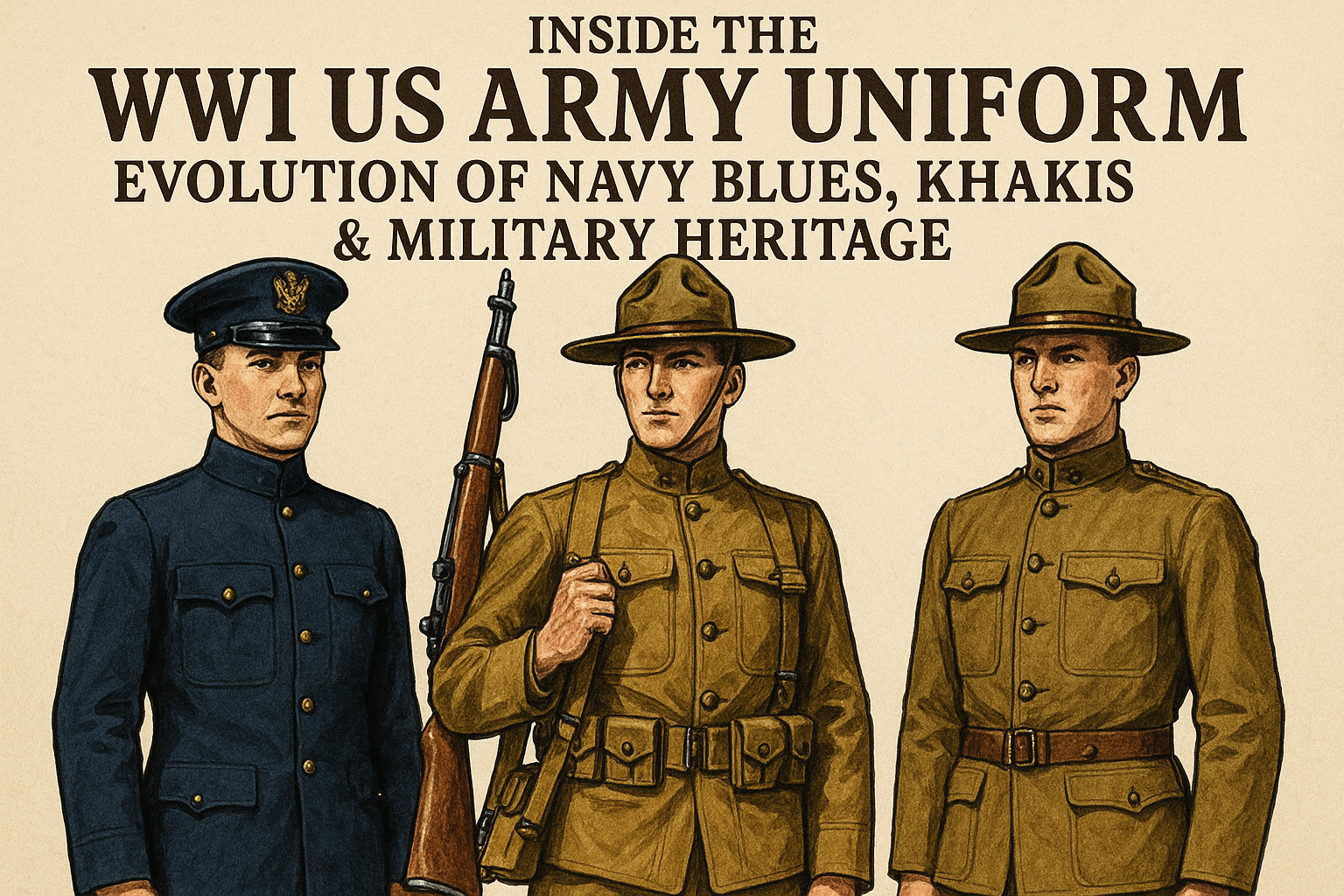
Inside the WWI US Army Uniform: Evolution of Navy Blues, Khakis & Military Heritage
Published on Jun 26, 2025
WWI US Army Uniform: A Blend of Function and Legacy
The First World War marked a significant shift in how the U.S. military approached combat, including how soldiers dressed. While today’s uniforms are streamlined for modern battlefields, much of the foundation was laid during World War I.
From the classic service dress blues worn by Navy officers to the rugged CPO khakis adopted for practicality, the WWI era represents one of the most fascinating times in U.S. military fashion. In this article, we’ll explore how the WWI US Army and Navy uniforms evolved and why these pieces still matter — historically, culturally, and aesthetically.
🪖 1. Early WWI Army Uniform Design: Utility Meets Tradition
When America entered the Great War in 1917, the existing U.S. Army uniform leaned more toward traditional European military dress — formal, wool-based, and often impractical for trench warfare. The original uniforms featured:
- Olive drab wool service coats
- Breeches and puttees (wool leggings)
- Flat-brimmed campaign hats
- Leather boots
These uniforms emphasized discipline and order but lacked adaptability. This need for function would soon push military attire in a new direction.
🟦 2. Navy Blues Uniform: A Symbol of Prestige
For naval officers, the service dress blues embodied tradition and command. These uniforms were ideal for cooler temperatures and included:
- A double-breasted navy blue coat with gold buttons
- Matching wool trousers
- Rank insignia on sleeves or shoulders
- Combination caps or white covers
The Navy Blues Uniform wasn't just ceremonial — it was part of the Navy's identity. Even in WWI, these uniforms were meticulously tailored, signaling authority and pride.
Collectors today still seek original navy blues for their craftsmanship and historical value. At Paddelaters.com, we offer museum-quality examples and reproductions to honor this legacy.
👕 3. The Practical Revolution: CPO Khakis and Field Adaptation
One of the most significant changes during WWI was the introduction of khaki as a standard military fabric — particularly for naval work uniforms and field-ready attire. The CPO (Chief Petty Officer) khakis became essential due to:
- Breathable cotton material
- Ease of laundering in the field
- Comfort in warm, humid conditions
- Simplicity of design (shirt and trouser sets)
This shift to us Navy service khaki marked the military’s gradual move from overly formal dress toward efficiency and performance-based gear.
⚓ 4. Navy and White Uniform: Ceremonial Elegance in Contrast
Contrasting with the ruggedness of khakis, the Navy and white uniform offered a striking, clean look that defined U.S. Navy tradition. Worn primarily in summer or during formal occasions, this uniform featured:
- A white jumper-style shirt
- White trousers with flared cuffs
- A traditional navy blue neckerchief
- White Dixie cup hat
Sailors on shore leave or participating in formal inspections often wore this style, cementing its place in American naval heritage. Even today, it's one of the most photographed and recognizable naval looks.
🧥 5. The Navy Jacket Uniform: Protection Meets Style
Among the most durable and beloved garments of the WWI Navy was the navy jacket uniform, a precursor to modern pea coats and deck jackets. These coats were designed to withstand cold ocean winds and long missions at sea.
Key features included:
- Heavy wool construction for insulation
- Anchor-button detailing
- Double-breasted front
- High collar and wide lapels for wind resistance
Today, this style has become a timeless outerwear staple in civilian fashion. However, for historians and collectors, the original WWI jackets represent functionality born out of necessity and refined through design.
🧭 6. Service Dress Blues Navy Officer: Formal Functionality
The service dress blue navy officer uniform was a status symbol reserved for higher-ranking officials during WWI. It reflected both the Navy's ceremonial traditions and the growing standardization of military attire.
This uniform often included:
- Tailored navy blue coat with gold braid detailing
- Shoulder epaulettes or sleeve stripes
- Sword belt and scabbard for officers on formal duty
This ensemble was — and still is — one of the most iconic and visually impressive in U.S. military history.
🛡️ 7. Why These Uniforms Still Matter Today
The WWI uniforms the U.S. Army and Navy wore were more than just garments. They represented:
- The birth of modern military dress standards
- Shifts in material science and manufacturing
- The beginning of mass uniform production
- Aesthetic influences that still appear in fashion and film
They also provide insight into how war demands innovation — not just in tactics but in every detail, according to the clothing soldiers wore on their backs.
🏁 Conclusion: A Lasting Impression in Fabric and History
From the sharp dignity of the navy blues uniform to the practical genius of the CPO khakis, the WWI US Army uniform era captures a decisive moment of change in military history. These uniforms weren’t just designed for battle — they were crafted for purpose, identity, and resilience.
At Paddelaters.com, we honor that legacy by offering high-quality reproductions, rare collectibles, and historically accurate pieces that tell the stories of those who served. Whether you're a passionate collector, a military history buff, or appreciate fine craftsmanship, these uniforms continue to inspire and educate.
Explore our collection today to experience a piece of history — and wear the stories that shaped a nation.
